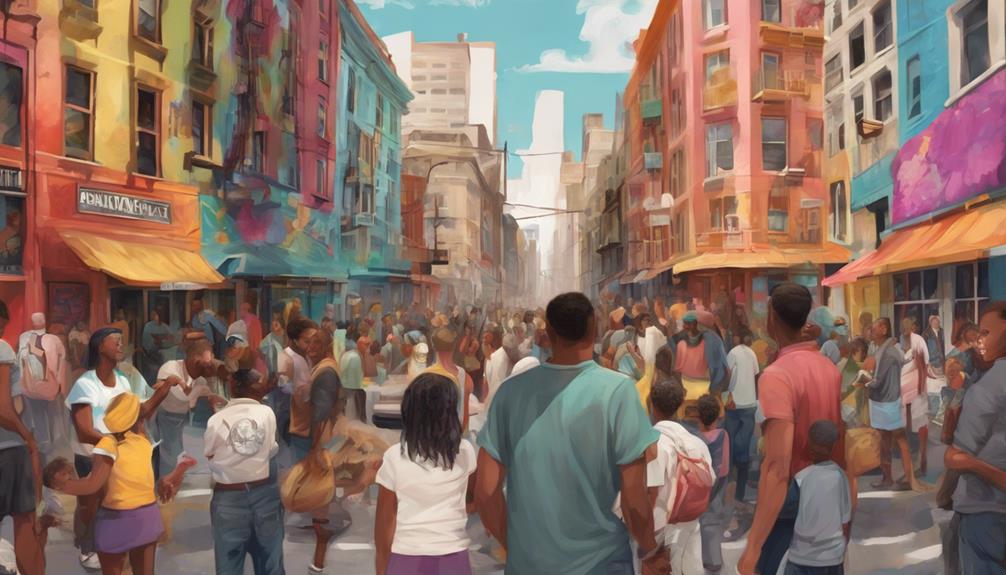Art's impact on society is a multifaceted subject that warrants careful examination. From challenging societal norms to fostering a sense of cultural identity, art plays a pivotal role in shaping the fabric of our communities. Its ability to spark dialogue, provoke introspection, and ignite change is undeniable. But how exactly does art wield this influence, and what are the implications for the future of our society? Let's delve into the intricate ways in which art intertwines with our everyday lives and contributes to the ever-evolving tapestry of human experience.
Key Takeaways
- Art shapes societal values, challenges norms, and provokes change.
- Art preserves cultural heritage and educates through diverse expressions.
- Art reflects cultural influences, societal commentary, and historical narratives.
- Art catalyzes social change, fosters education, and influences public perceptions.
Historical Significance of Art
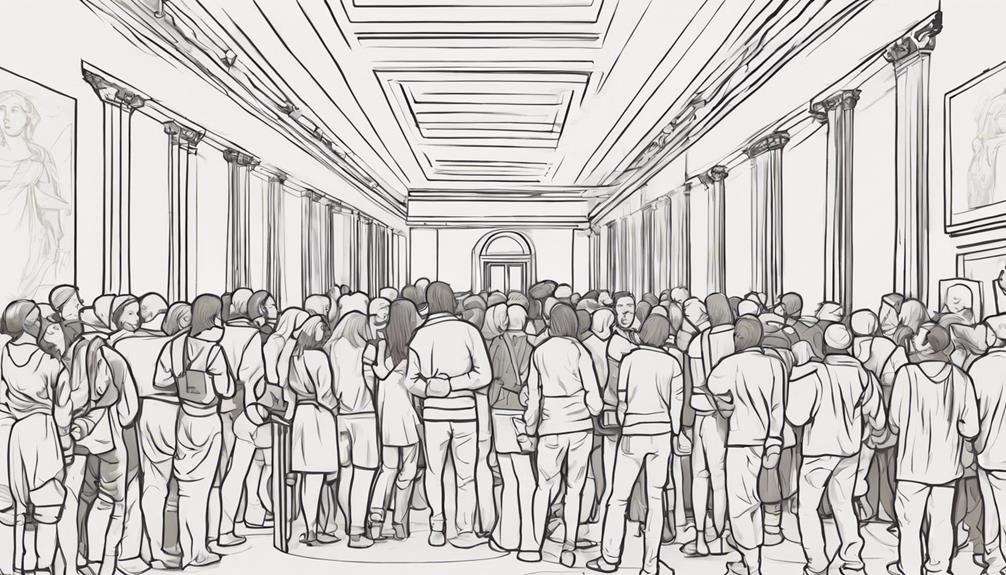
Art throughout history has played a pivotal role in shaping societies, acting as a mirror to reflect the values, advancements, and cultural narratives of different eras. The historical significance of art lies in its ability to serve as a form of communication, preserving the history and cultural heritage of societies. From prehistoric cave paintings to intricate Renaissance masterpieces, art has been instrumental in documenting the evolution of human civilization. It not only captures the aesthetics of a particular era but also conveys the beliefs, traditions, and societal norms prevalent at that time.
Furthermore, art has functioned as a primary tool for education, transmitting knowledge and values to future generations. Whether through religious paintings, epic poems, or oral storytelling, art has been a powerful medium for imparting lessons and shaping moral codes. Additionally, art has challenged established norms and values, provoking introspection and catalyzing societal change. By questioning existing paradigms, art has the capacity to foster critical thinking and stimulate dialogue on pressing social issues, thereby influencing the course of history.
Evolution of Art Forms
The evolution of art forms is a testament to the dynamic nature of human creativity and expression throughout history. Artistic trends over time reveal the adaptability of artists to changing societal influences and technological advancements. Cultural influences on art and the technological impact on artistic practices have played pivotal roles in shaping the diverse landscape of artistic expressions we witness today.
Artistic Trends Over Time
Throughout the annals of human history, the evolution of artistic trends has served as a visual chronicle of societal progress and cultural transformation. Artistic trends have transitioned from ancient cave paintings depicting daily life to the elaborate and realistic artworks of the Renaissance period. The 20th century witnessed the emergence of diverse art movements like Cubism, Surrealism, and Abstract Expressionism, challenging traditional norms. In contemporary times, new media art, street art, and digital installations have become prevalent, showcasing the fusion of technology and creativity. These trends not only reflect societal changes but also highlight the influence of technological advancements on artistic expression, shaping our understanding of the world around us.
Cultural Influences on Art
Amidst the dynamic tapestry of artistic evolution, the intricate interplay between cultural influences and artistic expression manifests a profound narrative of societal metamorphosis and creative innovation. Cultural influences have been instrumental in shaping artistic movements and the evolution of various art forms. From ancient civilizations to modern societies, art has been a reflection of the values, beliefs, and traditions of different cultures worldwide. The diversity and richness of global cultural expressions are evident in the evolution of painting, sculpture, music, and dance. By incorporating elements from different cultures, artists create a fusion that highlights the interconnectedness of art and society. This cross-pollination of ideas showcases how cultural influences continue to inspire and drive the continuous evolution of creative expressions on a global scale.
Technological Impact on Art
In the realm of artistic evolution, the infusion of technology has catalyzed a transformative shift in the landscape of art forms. The impact of technology on art is profound and multifaceted, leading to the emergence of digital art, interactive installations, and virtual reality experiences. Advancements in technology have revolutionized the art creation process, enabling artists to explore new mediums and techniques beyond traditional boundaries. Moreover, technology has democratized art, making it more accessible to a global audience through online platforms and digital galleries. The integration of technology in art has also fostered interdisciplinary collaborations, bridging art with fields such as science and engineering, resulting in innovative and boundary-pushing creations.
Art as a Reflection of Society
Art serves as a profound reflection of society, encapsulating the essence of societal challenges and triumphs through the creative expressions of artists. Artists capture the pulse of their times, offering a mirror to societal issues and shedding light on the struggles faced by marginalized communities. Their work often acts as a powerful commentary on political unrest and pressing societal matters, demanding attention and inspiring dialogue for positive change. Moreover, through their art, creators provide alternative narratives that challenge established norms, sparking new perspectives and critical thinking among viewers. This ability to present alternative viewpoints not only enriches the cultural discourse but also fosters a deeper understanding of complex societal issues. The table below further illustrates how art reflects society:
| Aspect | Description | Example |
|---|---|---|
| Reflection of Society | Art mirrors societal challenges and triumphs, providing insight into the era's essence. | Visual artwork depicting protests against injustice |
| Shedding Light | Art highlights social injustices faced by marginalized communities, bringing awareness to issues. | Photography series capturing homelessness |
| Challenging Norms | Artists offer alternative narratives that question established norms, encouraging critical thought. | Sculpture challenging traditional gender roles |
| Inspiring Dialogue | Artistic creations provoke discussions on pressing societal issues, fostering positive change. | Mural sparking conversations on environmental conservation |
Art's Influence on Cultural Identity
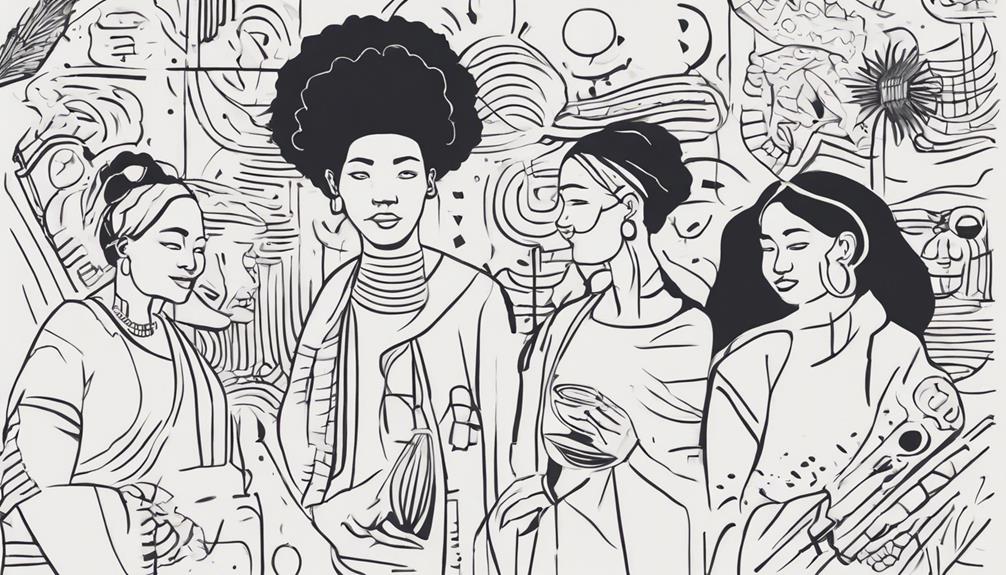
Art serves as a powerful means of cultural expression, allowing communities to showcase their unique identities through various art forms. Additionally, art often acts as a social commentary, reflecting the values, struggles, and triumphs of different cultural groups. By exploring how art influences cultural identity, we can gain insights into the complex interplay between artistic expression and societal values.
Cultural Expression Through Art
Cultural expressions through various artistic mediums play a pivotal role in shaping and preserving the collective identities of societies worldwide. Art serves as a powerful tool for cultural expression, reflecting the values, beliefs, and traditions of a society. Through art, cultural identities are preserved and celebrated, fostering a sense of belonging and pride. Different art forms, such as music, dance, and visual arts, convey unique cultural narratives and histories. Artistic expressions help communities connect with their heritage, promoting cultural diversity and understanding. Artistic representations of cultural identity in society contribute to the richness and vibrancy of global cultural landscapes.
- Art serves as a powerful tool for cultural expression
- Cultural identities are preserved and celebrated through art
- Different art forms convey unique cultural narratives
- Artistic expressions help communities connect with their heritage
- Artistic representations enrich global cultural landscapes
Art as Social Commentary
The intersection of artistic expression and societal critique provides a profound lens through which cultural identities are scrutinized and reinterpreted. Art serves as a medium for social commentary, challenging norms and perceptions about cultural identity. Artists use various forms of artistic expressions like murals, sculptures, and performances to address issues such as cultural appropriation, representation, and heritage preservation. Through their work, artists provoke thought, challenge stereotypes, and highlight the diverse facets of cultural identity. This form of expression allows marginalized communities to reclaim their narratives, share their stories, and assert their cultural identities. Artistic movements and styles often mirror the cultural struggles and identities of different communities, playing a pivotal role in shaping perceptions and fostering cross-cultural understanding.
| Social Commentary | Cultural Identity | Artistic Expressions |
|---|---|---|
| Challenges norms and perceptions | Reflects diverse facets | Murals, sculptures, performances |
| Provokes thought | Asserts cultural identities | Addresses cultural appropriation |
| Highlights cultural issues | Shapes perceptions | Promotes heritage preservation |
Art's Role in Preserving Tradition
Preserving tradition through artistic expression is a fundamental aspect of safeguarding cultural heritage for future generations. Art plays a crucial role in maintaining cultural continuity by serving as a bridge between the past and the present. Traditional art forms such as folk music, dance, and crafts carry within them historical narratives and values that have been passed down through generations. Indigenous art is particularly vital in reflecting unique cultural identities and preserving ancestral knowledge that might otherwise be lost over time. Artifacts and artworks, as tangible manifestations of cultural practices, play a significant role in preserving traditions by providing tangible links to the past. Additionally, traditional art practices act as a repository of customs, rituals, and beliefs, ensuring that the legacy of a community's heritage endures for years to come.
- Art maintains cultural continuity.
- Traditional art forms convey historical narratives and values.
- Indigenous art reflects unique cultural identities.
- Artifacts serve as tangible links to the past.
- Traditional art practices preserve customs, rituals, and beliefs.
Art as a Tool for Social Change
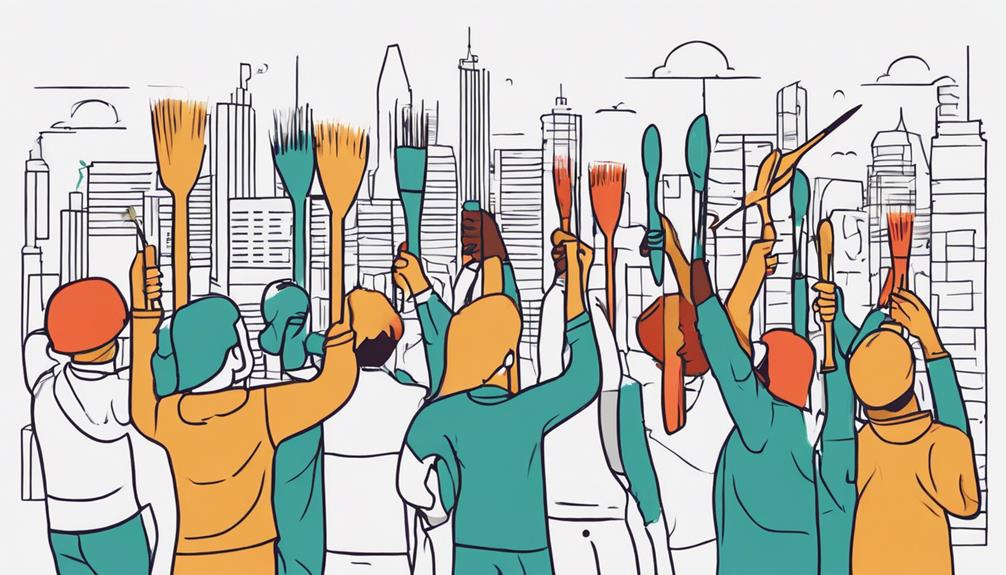
Art has proven to be a dynamic tool for inciting social change, channeling creativity into activism and pushing boundaries to inspire transformation. By leveraging the power of artistic expression, individuals and communities can challenge existing norms, spark crucial dialogues, and mobilize for a more equitable society. Through mediums like murals, music, and fashion, art not only communicates messages but also unites people in a common purpose, driving impactful movements for societal progress.
Art for Activism
In harnessing the expressive power of various art forms, activists effectively leverage creativity as a potent tool for instigating social change. Art for activism involves utilizing mediums like murals, music, and performances to advocate for social change and raise awareness. Artists contribute to activism by crafting thought-provoking pieces that challenge societal norms and address pressing issues. This form of art as a tool for social change empowers communities to voice their concerns, unite around causes, and drive meaningful action. Visual art and performances play a crucial role in historical social movements, influencing public opinion and inspiring activism. Through art, activists can visually communicate powerful messages, foster solidarity, and mobilize individuals to support crucial causes.
- Art for activism involves various art forms
- Activists create thought-provoking pieces
- Empowers communities to voice concerns
- Visual art and performances are instrumental in social movements
- Artists visually convey powerful messages
Influence Through Creativity
Utilizing creativity as a transformative force, artists harness the power of expression to catalyze social change and address critical societal issues through various art forms. Art plays a significant role in influencing society by shedding light on pressing matters such as inequality, injustice, and discrimination. Through their creative works, artists challenge existing norms, stimulate critical thinking, and motivate individuals to take action towards positive transformations. Artistic mediums like murals, installations, and performances serve as impactful visual statements that bring communities together and fuel movements for social activism. Contemporary artists are actively engaging with important social issues like environmental degradation, human rights abuses, and political turmoil, using their art to advocate for change and contribute to the creation of a more just and equitable society.
Inspiring Societal Transformation
The transformative potential of creative expression as a catalyst for societal change is exemplified through the profound impact of artistic endeavors on shaping collective perspectives and inciting action. Art serves as a powerful tool for social change, inspiring activism and raising awareness on pressing issues like inequality and injustice. Through various art forms like murals and installations, artists provoke thought, challenge norms, and drive conversations around societal transformation. Artistic expressions can unite communities, foster solidarity, and empower individuals to advocate for a more just and equitable society. Contemporary artists use their work to address critical social issues such as climate change, human rights, and political activism, sparking dialogue and promoting change. Art's impact on society lies in its ability to inspire action, evoke empathy, and serve as a catalyst for positive societal transformation through creative expression.
Art's Impact on Emotional Well-being
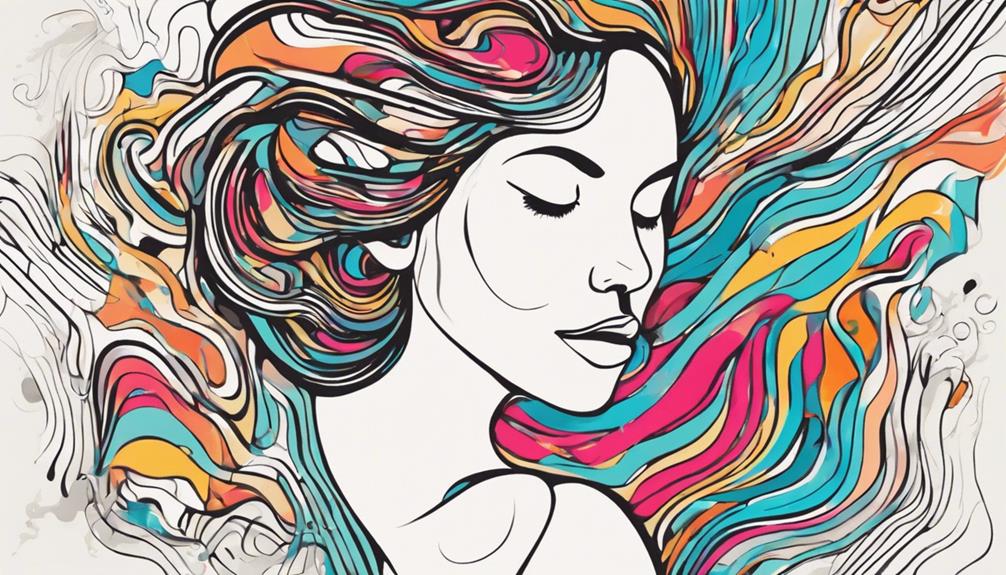
Art plays a significant role in shaping individuals' emotional well-being by providing a platform for expression and reflection. Engaging with art has been proven to reduce stress and anxiety, thus promoting emotional well-being. Art therapy is a recognized method for helping individuals manage mental health issues and enhance their overall quality of life. Through creating or consuming art, individuals can find a therapeutic outlet that allows for emotional expression and processing, contributing positively to their emotional well-being. Studies have highlighted that art can boost self-esteem and confidence levels, further enhancing emotional well-being. These emotional benefits of art are crucial in promoting positive mental health outcomes and supporting personal growth. By offering a space for individuals to explore and express their emotions, art has the power to nurture emotional well-being, offering solace and growth opportunities.
Art's Ability to Challenge Norms
In the realm of societal influence and cultural discourse, artistic expressions wield a formidable power in challenging established norms and ideologies. Art has the ability to challenge norms, provoke thought, and push boundaries, thereby sparking important conversations and reflections within society. Through their work, artists actively question the status quo and provoke viewers to reevaluate their beliefs and perspectives. By pushing boundaries, art can disrupt traditional values and inspire change in societal attitudes. Artistic expressions often serve as a catalyst for debates surrounding controversial issues, inviting individuals to engage critically with the art and the ideas it presents. This disruptive nature of art plays a crucial role in shaping cultural discourse and encouraging societal progress towards more inclusive and diverse perspectives. Art's capacity to challenge norms serves as a vital force in driving social change and promoting a more nuanced understanding of the world around us.
Political Commentary Through Art
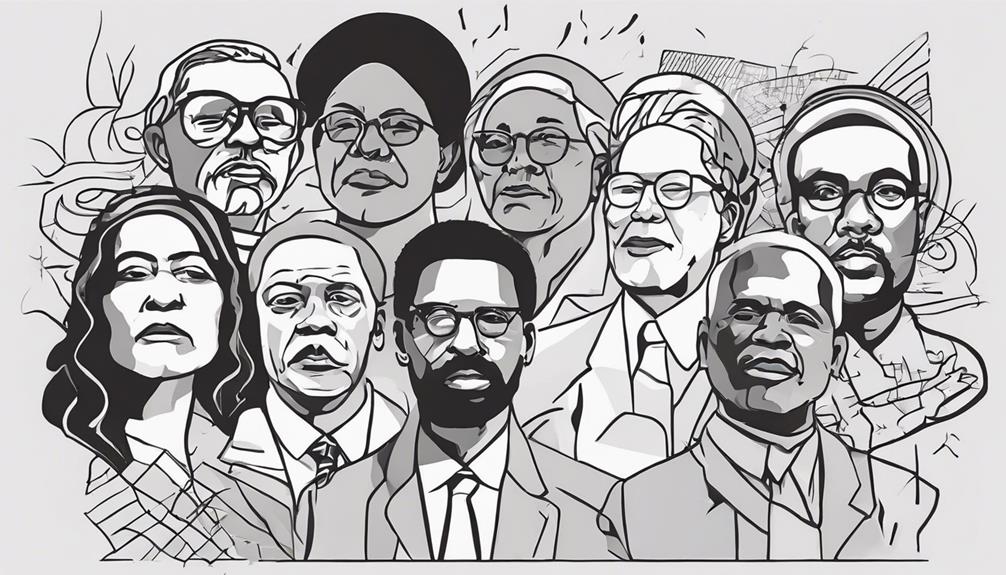
Artistic expressions have long served as potent vehicles for critiquing authority and instigating social reform, with political commentary through art standing as a prominent example of challenging prevailing power structures. Artists utilize various mediums such as paintings, sculptures, and street art to shed light on societal issues, advocating for change and highlighting injustices. Political art serves as a visual representation of dissent, sparking conversations and increasing awareness within the public sphere. Through protests, exhibitions, and public installations, artists contribute to amplifying voices of resistance and activism, pushing for transformation and accountability. By incorporating thought-provoking imagery and symbolism, political art prompts viewers to reflect, engage critically with current affairs, and potentially incite action towards addressing the underlying problems. The table below illustrates the impact and significance of political commentary through art:
| Political Art | Societal Impact | Activism |
|---|---|---|
| Challenges authority and power structures | Raises awareness and sparks dialogue | Inspires social change and accountability |
Art's Contribution to Community Building
Conducive to social cohesion and fostering a sense of belonging, art plays a pivotal role in community building through its facilitation of shared creative spaces. Collaborative art initiatives, in particular, have a profound social impact by engaging diverse groups within a community, fostering dialogue, understanding, and ultimately enhancing social cohesion. Public art installations and community projects not only beautify neighborhoods but also instill a sense of pride and unity among residents. Additionally, community art events and workshops serve as platforms for people to come together, fostering networking opportunities, cultural exchange, and relationship building. By empowering individuals to address local issues and build connections, art-based community programs play a significant role in strengthening the social fabric of neighborhoods. Through these various avenues, art contributes significantly to the development of inclusive and vibrant communities where individuals feel connected and supported.
Art's Influence on Public Opinion
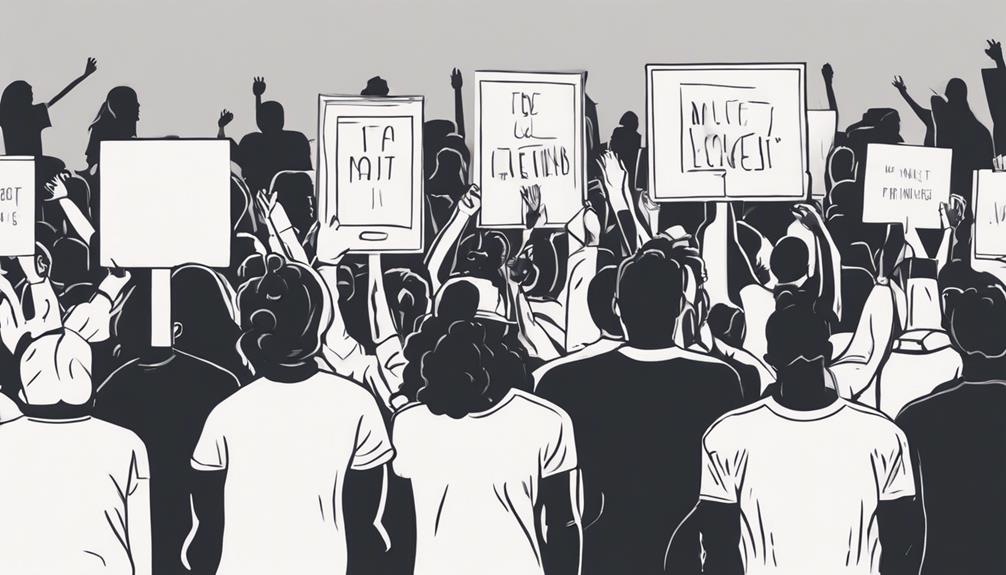
Art's influence on public opinion is profound, as art has the capacity to shape perceptions and ignite societal change. Through various artistic mediums, artists challenge norms, provoke critical thinking, and inspire action within communities. The power of creative expression lies in its ability to sway public attitudes, beliefs, and behaviors, ultimately driving meaningful shifts in society.
Shaping Public Perceptions
Shaping public perceptions through artistic expressions involves presenting diverse viewpoints and challenging established norms, ultimately influencing public opinion on a range of societal issues. Art plays a crucial role in shaping public perceptions by addressing social issues, promoting critical thinking, and offering a platform for diverse perspectives. The impact of art on public opinion is profound, as it can provoke discussions, evoke emotions, and prompt reflection on complex societal challenges. Through visual and emotional storytelling, art serves as a catalyst for change, encouraging individuals to reconsider their beliefs and attitudes towards pressing social matters. Additionally, art acts as a powerful tool for mirroring society's values, struggles, and aspirations, influencing how people perceive and engage with the world around them.
- Art addresses social issues
- Art promotes critical thinking
- Art offers diverse perspectives
- Art provokes discussions
- Art encourages reflection
Inspiring Social Change
The influence of artistic expressions on public opinion and societal attitudes towards pressing issues has historically been a driving force behind inspiring social change and fostering critical dialogue. Art has the power to inspire action, acting as a catalyst for change by challenging existing norms and initiating thought-provoking conversations. Through powerful visuals and messages, art influences public opinion, shaping attitudes and beliefs. Artists utilize various mediums such as murals, protests, and installations to spark dialogue and serve as agents of social change. By raising awareness and encouraging critical thinking, art plays a crucial role in shaping public perceptions, fostering empathy, and driving positive transformations in society.
| Artistic Expressions as Catalysts for Social Change |
|---|
| Challenge norms and provoke critical conversations |
| Influence public opinion and shape societal attitudes |
| Inspire action and drive positive change |
| Raise awareness and spark dialogue |
| Foster empathy and encourage critical thinking |
Art's Role in Education
Education's integration of art plays a pivotal role in nurturing students' critical thinking skills, creativity, and innovation. Arts education goes beyond just teaching students how to draw or paint; it fosters a range of skills and abilities that are crucial for success in today's world. Here are some key ways in which art contributes to education:
- Fosters critical thinking skills: Engaging with art prompts students to think critically, analyze information, and make informed judgments.
- Enhances creativity: Art encourages students to think outside the box, explore new ideas, and approach challenges from different perspectives.
- Improves problem-solving abilities: Through art, students learn to experiment, adapt, and find creative solutions to complex problems.
- Develops soft skills: Art education helps students hone essential soft skills such as communication, collaboration, and adaptability.
- Enhances cognitive development: Integrating art into education stimulates cognitive processes, improving memory, attention, and spatial reasoning.
Art's Connection to Technology
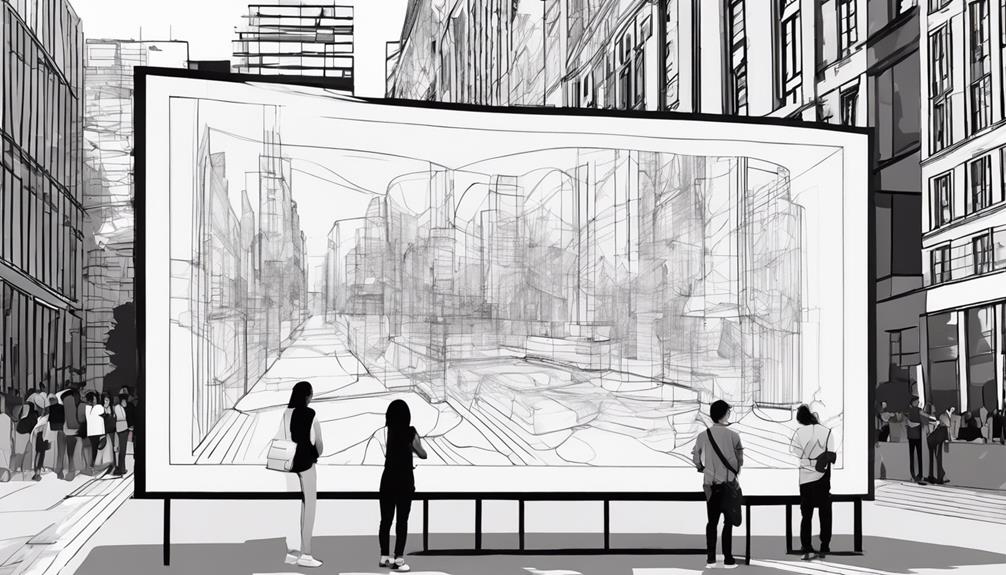
Art's integration with technology has reshaped traditional artistic practices and fostered a dynamic intersection of creativity and innovation in today's digital landscape. The advent of technology has revolutionized the art world, providing artists with tools to create digital artworks, virtual reality experiences, and interactive installations. Collaborations between art and technology have resulted in groundbreaking exhibitions, such as immersive digital art shows and interactive museum experiences. The use of digital tools like graphic design software, 3D printing, and virtual reality has not only expanded artistic possibilities but also enhanced audience engagement. Furthermore, online platforms and social media have played a significant role in democratizing art access, allowing artists to exhibit their work globally and connect with diverse audiences. This intersection of art and technology has sparked the emergence of new forms of creativity, blending traditional art practices with cutting-edge technological advancements to create a unique and impactful fusion in the art world.
Art's Influence on Global Relations
How does art serve as a catalyst for fostering stronger global relations and promoting cultural understanding? Art's influence on global relations is significant, acting as a powerful tool for communication and connection across borders. Through cultural diplomacy and artistic exchanges, art has the ability to transcend differences and cultivate mutual respect among nations. Here are some ways art impacts global relations:
- Bridging Cultural Divides: Art has the power to bridge cultural gaps, fostering understanding and empathy among diverse communities.
- Promoting Diplomacy: Cultural exchange initiatives such as art exhibitions play a crucial role in promoting diplomacy and strengthening international relations.
- Transcending Boundaries: Artistic expressions can transcend language barriers, creating connections that go beyond geopolitical boundaries.
- Enhancing Cooperation: Artistic exchanges between countries promote peace, dialogue, and mutual respect, ultimately enhancing global cooperation.
- Building Lasting Relationships: Collaborative art projects between nations not only promote cultural diplomacy but also build lasting relationships that endure political differences.
Future Trends in Art and Society
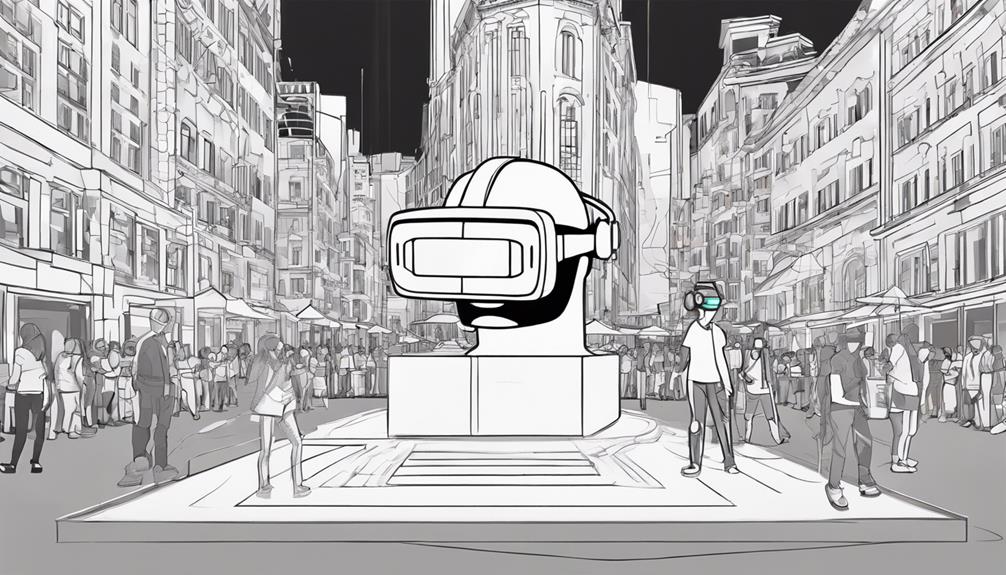
The evolution of art in tandem with societal changes is reshaping cultural landscapes and influencing the trajectory of human expression. Looking ahead, future trends in art creation and consumption are poised to be heavily influenced by emerging technologies such as virtual reality and artificial intelligence. These innovations offer artists new mediums for creative exploration and provide audiences with immersive art experiences. Additionally, collaborative and community-based art projects are on the rise, fostering social engagement and inclusivity within artistic endeavors. Art is also increasingly being leveraged as a powerful tool for environmental activism and sustainability awareness, reflecting society's growing concern for these issues.
Moreover, the art market is undergoing a transformation with the advent of digital art platforms and Non-Fungible Tokens (NFTs), revolutionizing how art is bought, sold, and valued. This shift not only affects artists' monetization strategies but also challenges traditional notions of ownership and authenticity in the art world. Furthermore, the recognition of art therapy for its mental health benefits is leading to a greater integration of art in healthcare settings, indicating a broader acceptance of art as a therapeutic and healing medium in society's future landscape.
Frequently Asked Questions
How Does Art Have an Impact on Society?
Artistic expression influences societal change by challenging established norms and fostering critical dialogue. Through its cultural influence, art provokes thought, inspires activism, and empowers communities to advocate for a just society. Alternative narratives presented in art spark new perspectives, driving meaningful change. Movements like Dadaism and Pop Art exemplify how art can question societal norms and push boundaries, ultimately shaping the collective consciousness and driving social progress.
What Is the Impact of Modern Art on Society?
Exploring creativity through avant-garde forms and daring expressions, modern art challenges societal influences and reshapes cultural perceptions. By pushing boundaries and provoking thought, it fosters critical dialogue and introspection. Modern art serves as a mirror to the evolving world, capturing the essence of contemporary issues and reflecting diverse perspectives. Its impact on society lies in its ability to inspire innovation, promote inclusivity, and deepen understanding of complex realities through artistic interpretation.
How Do Visual Arts Impact Humanity and Society?
Visual arts, through cultural expression, facilitate social change by fostering emotional connections. Artists utilize various mediums like paintings and sculptures to convey messages that resonate with humanity, prompting reflection and dialogue. This engagement with visual arts not only enhances individual perspectives but also influences societal attitudes and behaviors. By capturing diverse human experiences and emotions, visual arts serve as a powerful tool for promoting empathy, understanding, and unity within society.
How Does Art Bring Awareness to the Society?
Art brings awareness to society by acting as a catalyst for social change through cultural representation and activism. It engages communities through artivism, utilizing visual expressions to spark dialogue and reflection on pressing societal issues. By highlighting injustices and struggles faced by marginalized groups, art fosters empathy and understanding among the public. Through public installations and performances, art draws attention to important concerns, igniting critical conversations and inspiring action towards positive change.
Conclusion
In conclusion, art plays a crucial role in shaping society by providing a platform for self-expression, fostering awareness of social issues, and inspiring meaningful change. One interesting statistic to consider is that according to a study by Americans for the Arts, arts and culture industries contribute over $800 billion to the U.S. economy annually. This highlights the significant impact of art on society, both culturally and economically.
